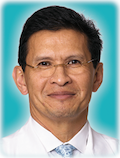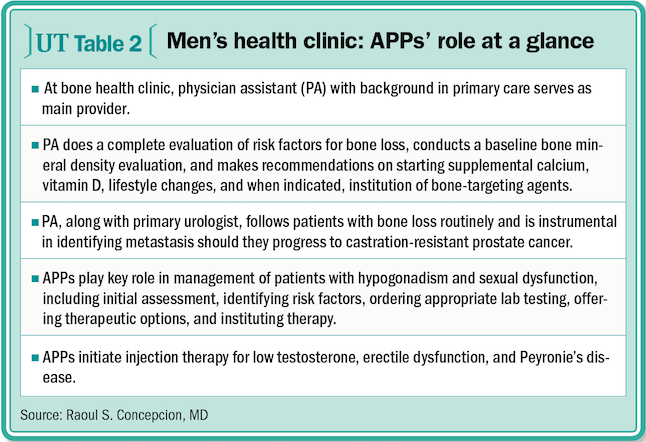Article
Working with APPs: Best practices from a successful practice
Author(s):
Raoul S. Concepcion, MD, uses his group's experience to illustrate how other urology groups can successfully incorporate APPs into their practice model and provide state-of-the-art care.

The physician work force crisis is upon us. A March 2015 study released by the Association of American Medical Colleges reports that by 2025, there will be a projected shortage in the United States of 12,000–31,000 primary care physicians and 28,000–63,000 non-primary care doctors, most notably in the surgical specialties (“The Complexities of Physician Shortage and Demand: Projections from 2013–2015, Final Report,” Association of American Medical Colleges, March 2015). This takes into account the aging population, current medical school and resident program trends, and the effect of the Affordable Care Act.
Related - Working with NPs, PAs: What AUA statement means to your practice
For urology, the outlook is even more dire. With the current age of practicing urologists in the country and the number of new residents projected, it is estimated by 2030, the United States will face a 32% shortage in order to provide adequate care for our aging population (Ann Surg 2009; 250:590-7).
To try and combat this paucity of physicians in both the academic and community/independent practice environment, utilization of advanced practice providers (APPs) has burgeoned over the past decade, especially in the urology world. Chaired by my friend and colleague Chris Gonzalez, MD, MBA, current vice-chair of its Public Policy Council, the AUA in 2014 issued a consensus statement in support of APPs and their role in urologic practice (Urology Practice, published online May 6, 2015). I would encourage all readers to be familiar with this comprehensive document.
As you likely know, the definition of APPs can be broken down into two broad categories: advanced practice registered nurses (APRNs) and physician assistants (PAs). Their educational background and scope of practice is different and very much state regulated. The purpose of this article is not to provide an exhaustive review of the particular nuances between the two professions. Rather, it is meant to use our group’s experience to illustrate how other urology groups can successfully incorporate APPs into their practice model and provide state-of-the-art care, given the ever-increasing demands on our time (with less reimbursement) in the fluid health care environment.
NEXT: An integrated model
More from Urology Times
APPs: Collaborators, not competitors
Blog: Practice ‘efficiency’ is not a dirty word but a noble goal
What’s your opinion on targeted biopsy for prostate cancer?
An integrated model
Urology Associates, P.C. in Nashville, TN is a single-specialty group with 32 MDs and 12 APPs (seven APRNs and five PAs) working in an integrated fashion. We have utilized APPs for well over a decade. Working them into our business model has allowed us to keep up with the demand of the growing population and need for urologic care in middle Tennessee.
Traditionally, the canonical thinking about how to utilize APPs has been to see patients in the outpatient setting under the supervisory role of a board-certified urologist. This allows a higher volume of patients to be seen and possibly allows the physician to be more productive in other areas where reimbursement may be higher. We have continued that model to some degree, but have also created new service lines within the practice that are a source for not only new patients but revenue as well.

Women’s health. The WISH clinic (Women’s Institute for Sexual Health) was one of our first forays into a dedicated specialty service line. The FDA approval of sildenafil citrate (Viagra) for male erectile dysfunction in 1998 started a new era of drug development for sexual issues. It became readily apparent to us that female sexual dysfunction was being largely ignored, not only by urology but also by primary care and gynecology as well. As we are well aware, there are many factors that contribute to this, including female sexual dysfunction’s multifactorial etiology, vague definitions of dysfunction, and lack of therapies.
Read: ICD-10, quality initiatives present hurdles, solutions
In recognition and response to this demand, we hired an APRN whose background and clinical expertise was in women’s health (table 1). She was charged with developing the clinic. After spending time with experts at practices that had similar interests, she was able to launch our endeavor, which included establishing relationships with other health care professionals, including OB/GYNs, behavioral medicine experts, and compounding pharmacies, among others.
The WISH clinic, supervised by one of our urologists who works with a team of dedicated APPs, has been able to provide comprehensive management to women with both sexual and pelvic health issues. The APRNs see the majority of new patients referred, whether from within our practice, primary care physicians, or self referred. They perform all the urodynamic testing and make referrals when appropriate.
NEXT: Men's health
Men’s health. Dovetailing with the success of WISH, we also created a Men’s Health Clinic (MHC) within the practice. Under this umbrella, we manage and diagnose a number of disease states. Our APPs are vital and are often the first provider to evaluate these patients and institute therapies (table 2).
The early catalyst was our involvement in clinical trials of bone-targeting therapies in men with both metastatic and non-metastatic prostate cancer. As urologists, we induce bone mineral density loss (and metabolic issues) with the delivery of androgen deprivation therapy (ADT) in men with advancing prostate cancer. This percentage loss can be significant, and the urology world has been slow to recognize and manage this potentially devastating complication. In men with metastatic castration-resistant prostate cancer, bone loss can obviously be further amplified.

The recognition and willingness to identify and treat these patients within the practice is paramount and constitutes appropriate, evidence-based patient care. A PA with a background in primary care leads this initiative and serves as the main provider at our bone health clinic. Generally, we mandate that when a patient with prostate cancer is ready to start ADT, he is automatically referred to the clinic. The PA does a complete evaluation of risk factors, conducts a baseline bone mineral density evaluation, and makes recommendations on starting supplemental calcium, vitamin D, lifestyle changes, and when indicated, institution of bone-targeting agents. Along with the primary urologist, he follows patients on a routine basis and is also instrumental in the early identification of metastasis should they progress to castration-resistant disease.
Also see - Personalized messaging: Communicating with men about their health
The MHC also incorporates therapy and evaluation for hypogonadism and sexual dysfunction. In response to outside entities that advertise for the same services, we felt the urology practice should be the primary driver in this area. Again, whether patients be self referred or from within the practice, the APPs are crucial in their initial assessment, identifying risk factors, ordering appropriate lab testing, offering therapeutic options, and instituting therapy. This would also include injection therapy for low testosterone, erectile dysfunction, or Peyronie’s disease.
The biggest challenge in this part of the practice is getting the practice’s physician partners to refer to the MHC. They are often reluctant, feeling that they will lose control of the patient. We have stressed that the function of the clinic is to work with the primary urologist for optimal patient care and retention within the practice.
Hospital setting. Another area that is also important to both practice and physician efficiency is the use of the APP in a hospital setting. Again, depending on the scope of practice unique to your state, the APP can assist in making rounds, seeing consults, taking call, and even performing certain procedures. This allows the supervisory physician to be more flexible in scheduling and seeing patients.
NEXT: Keys to success
Keys to success
In preparation for writing this article, I asked a number of APPs within our practice a simple question: In your opinion, what are the keys to success in incorporating APPs into a urology practice? Their answers, in order of importance, were all in line:
- The APP and supervising physician need to work together as a team to promote the best patient care. The APP should viewed as a colleague and not a “helper” or somewhere down on the pecking order.
- The APP and supervising urologist must communicate effectively.
- The scope of practice and unique abilities that each APP can bring to patient management must be clearly understood.
- Stay current and make attempts to practice evidence-based medicine.
- Interact constantly with and provide educational events for the APP.
Conclusion
A number of years ago, just prior to the explosion of online music and sharing, a good friend in the music industry continued to push his friends to buy compact discs. A decade later, I asked him, knowing what he knows now with digital, online, and cloud-based music-sharing capabilities, what he would have done differently if he could go back in time. His answer was very quick and simple: He would have embraced the model and figured out how to incorporate it into his business. With our looming physician shortage in urology, we need to embrace APPs into our practices in order to optimize patient care.
Have you read:
Pediatric hypospadias repair in 2015
Active surveillance on the rise but still underused
Weight-loss surgery may reduce incontinence

Subscribe to Urology Times to get monthly news from the leading news source for urologists.

















